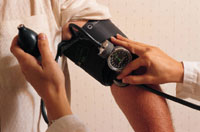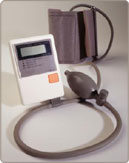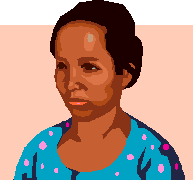When the heart beats, it pumps blood to the arteries and creates pressure in them. This pressure (blood pressure) results from two forces. The first force is created as blood pumps into the arteries and through the circulatory system. The second is created as the arteries resist the blood flow.
If you’re healthy, your arteries are muscular and elastic. They stretch when your heart pumps blood through them. How much they stretch depends on how much force the blood exerts.

Your heart beats about 60 to 80 times a minute under normal conditions. Your blood pressure rises with each heartbeat and falls when your heart relaxes between beats. Your blood pressure can change from minute to minute, with changes in posture, exercise or sleeping, but it should normally be less than 140/90 mm Hg for an adult. Blood pressure that stays above this level is considered high. Your doctor may take several readings over a period before making a judgment about whether your blood pressure is considered to be in a high level range.
What do blood pressure numbers indicate?
High blood pressure, or hypertension (hi”per-TEN’shun), is defined in an adult as a systolic pressure of 140 mm Hg or higher and/or a diastolic pressure of 90 mm Hg or higher. Blood pressure is measured in millimeters of mercury (mm Hg).
- The higher (systolic) number represents the pressure while the heart is beating.
- The lower (diastolic) number represents the pressure when the heart is resting between beats.
The systolic pressure is always stated first and the diastolic pressure second. For example: 122/76 (122 over 76); systolic = 122, diastolic = 76.
Blood pressure of less than 140 over 90 is considered a normal reading for adults. A systolic pressure of 130 to 139 or a diastolic pressure of 85 to 89 needs to be watched carefully. A blood pressure reading equal to or greater than 140 (systolic) over 90 (diastolic) is considered elevated (high).
|
High blood pressure directly increases the risk of coronary heart disease (which leads to heart attack) and stroke, especially along with other risk factors.
High blood pressure can occur in children or adults. It’s particularly prevalent in African Americans, middle-aged and elderly people, obese people and heavy drinkers. People with diabetes mellitus (di”ah-BE’teez or di”ah-BE’tis meh-LI’tis) gout or kidney disease have hypertension more often.
High blood pressure usually has no symptoms. It’s truly a “silent killer.” But a simple, quick, painless test can detect it.
What Causes High Blood Pressure?
In 90 to 95 percent of high blood pressure cases, the cause is unknown. In fact, you can have high blood pressure for years without knowing it. That’s why it’s the silent killer ? it creeps up on you. When the cause is unknown, you have what’s called essential or primary hypertension. Factors that may lead to high blood pressure in the remaining 5?10 percent of cases, which are known as secondary hypertension, include:
- Kidney abnormality
- A structural abnormality of the aorta (large blood vessel leaving the heart) existing since birth
- Narrowing of certain arteries
These problems can be corrected. For example, doctors can repair a narrowed artery that supplies blood to a kidney. Most of these problems can be ruled out by a careful history, a physical examination and a few tests. Special tests are sometimes needed, but you don?t usually have to stay in the hospital.
How does high blood pressure develop?
Your heart pumps blood through the body’s arteries. The large arteries that leave your heart taper down to smaller arteries called arterioles. The arterioles then taper down into smaller vessels called capillaries, which supply oxygen and nutrients to all the organs of your body. The blood then returns to your heart through the veins.
Certain nerve impulses cause your arteries to dilate (become larger) or contract (become smaller). If these vessels are wide open, blood can flow through easily. If they?re narrow, it?s harder for the blood to flow through them, and the pressure inside them increases. Then high blood pressure may occur. When this happens, your heart becomes strained and blood vessels may become damaged. Changes in the vessels that supply blood to your kidneys and brain may cause these organs to be affected.
Your heart, brain and kidneys can handle increased pressure for a long time. That’s why you can live for years without any symptoms or ill effects. But that doesn’t mean it’s not hurting you. High blood pressure is a key risk factor for a stroke, heart attack and kidney failure.
What does high blood pressure do to your body?
High blood pressure adds to the workload of your heart and arteries. Your heart must pump harder, and the arteries carry blood that?s moving under greater pressure. If high blood pressure continues for a long time, your heart and arteries may not function as well as they should. Other body organs may also be affected. There is increased risk of stroke, congestive heart failure, kidney failure and heart attack. When high blood pressure exists with obesity, smoking, high blood cholesterol levels or diabetes, the risk of heart attack or stroke increases several times.
What about low blood pressure?
Within certain limits, the lower your blood pressure reading is, the better. In most people, blood pressure isn?t too low until it produces symptoms, such as lightheadedness or fainting. In certain disease states, it?s possible for blood pressure to be too low. Examples include:
- Certain nerve disorders or endocrine disorders
- Prolonged bed rest
- Decreases in blood volume due to severe bleeding (hemorrhage) or dehydration
Blood pressure less than 120/80 mm Hg is generally considered ideal. Levels higher than this increase your risk for cardiovascular disease. If you have unusually low blood pressure, you need to have it evaluated.
How Do I know If I Have High Blood Pressure?
High blood pressure usually has no symptoms. In fact, many people have high blood pressure for years without knowing it. It doesn’t refer to being tense, nervous or hyperactive. You can be a calm, relaxed person and still have high blood pressure. The only way to find out if you have high blood pressure is to have it checked! A blood pressure test is quick and painless. You can have it done in a doctor’s office, hospital clinic, school, nurse’s office, company clinic or at a health fair.
A single reading showing high blood pressure doesn’t mean you have high blood pressure, but it’s a sign that you need to watch it carefully. If your blood pressure is normal, get it checked at least every two years. If your blood pressure is near the top of the normal range, or if you have a family history of high blood pressure, you’re at higher risk. Your doctor will tell you how often to have it checked.
How is blood pressure checked?
Blood pressure is measured using a medical instrument called a sphygmomanometer. A rubber cuff is wrapped around person’s upper arm and inflated. When the cuff is inflated, it compresses a large artery in the arm, momentarily stopping the blood flow.
Next, air in the cuff is released, and the person measuring the blood pressure listens with a stethoscope. When the blood starts to pulse through the artery, it makes a sound; sounds continue to be heard until pressure in the artery exceeds the pressure in the cuff.

While the person listens and watches the gauge, he or she records two measurements. Systolic pressure is the pressure of the blood flow when the heart beats (the pressure when the first sound is heard). Diastolic pressure is the pressure between heartbeats (the pressure when the last sound is heard). Blood pressure is measured in millimeters of mercury, which is abbreviated mm Hg.
Are there larger and smaller blood pressure cuffs for overweight people and children?
Children and adults with smaller or larger than average-sized arms may need special-sized cuffs, available in some pharmacies and from medical supply companies. They may also be ordered directly from companies that sell blood pressure cuffs. Ask your doctor or pharmacist for help.
A Special Message for African Americans
If you’re African American, there’s a good chance that you, a relative or a friend has high blood pressure, or hypertension. It affects about one out of three African Americans. High blood pressure develops earlier in life in blacks than in whites and is usually more severe. The longer it’s left untreated, the more serious its complications can become. High blood pressure is also a major risk factor for heart attack, stroke and kidney failure. Because this disease is so serious, early detection and treatment are very important.

A Special Message For Women
Many people think of high blood pressure (hypertension) as a “stress disease” ” the result of overwork, no exercise, too many cocktail lunches, too much smoking, bad diet and a thousand other things we do in our tense society. The fact is, doctors don’t know what causes high blood pressure except in a few rare cases. What they do know is that more than 50 million Americans have it, and nearly half are women. And only a small portion of all those with the disease are adequately treated.
Why does it matter? Because high blood pressure is a killer. It leads to heart failure, stroke, heart attack, kidney damage, blindness and more.
There are no reliable symptoms of high blood pressure. But as a woman, you should know about some clues that may help you deal with this disease.
If you’re taking the Pill…
Doctors have found that taking birth control pills is linked with high blood pressure in some women. This is more likely to happen if you’re overweight, have had hypertension during pregnancy, or have a predisposing condition, such as mild kidney disease or a family history of high blood pressure. So it’s a good idea to ask your doctor to measure your blood pressure before prescribing the Pill, and then to have your blood pressure checked every six months or so. The combination of birth control pills and cigarette smoking may be especially dangerous in some women.
If you’re pregnant…
Physicians usually keep a close watch on blood pressure during pregnancy, because hypertension can develop rapidly in the last three months. It’s dangerous to mother and baby if not treated. This kind of hypertension usually disappears after delivery, but if it doesn’t, it should be controlled with careful, long-term treatment as recommended for all other hypertension.
For women who already have high blood pressure, pregnancy could make the condition more severe. Careful treatment allows a normal pregnancy and a normal baby.
If you’re overweight…
Being overweight or gaining a lot of weight increases the possibility of developing high blood pressure. This is one reason why it’s important to maintain normal weight throughout your life.
After menopause…
As a woman grows older, her chance of having high blood pressure becomes greater than a man’s. Although you may have had normal blood pressure most of your life, the chance of your getting high blood pressure increases considerably after menopause.
If your family has a history of high blood pressure…
If your parents and other close blood relatives have had high blood pressure, there’s a good chance that you have it or may develop it, too. And if you have it, it’s quite possible that your children may also develop it. Like adults, children should have regular blood-pressure checks.
Is There a Cure for High Blood Pressure?
There isn’t any. Not yet, anyway. But the important thing is that high blood pressure is controllable. To control your blood pressure, you’ve got to participate as part of a healthcare team. Your doctor, nurse, and other team members can’t do it alone — and neither can you. You must all work together.
You may have to take medication every day, perhaps for the rest of your life. And there may be other treatments, such as losing weight, using less salt, getting more exercise and limiting alcohol intake.
But think about what could happen with untreated high blood pressure. Don’t take life-or-death chances with a disease you can control.
